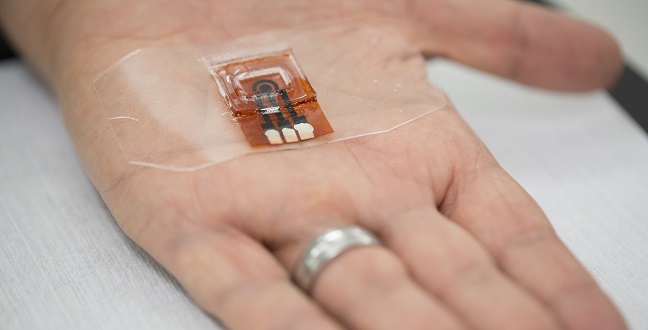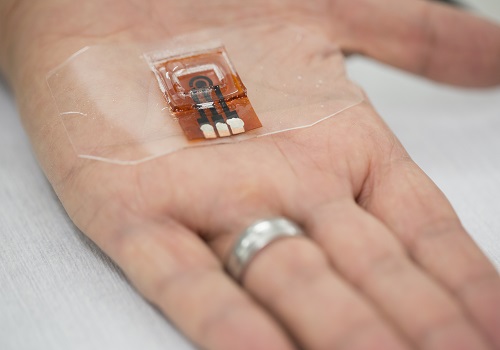Material Science and Engineering
Better biosensors on edge
Inscribing porous, carbonized patterns into a polymer creates sensitive electrodes that detect biological molecules.


This chemical sensor contains graphene-based electrodes that were inscribed into the underlying polymer using a laser.
© 2016 KAUST H. Alshareef
Using a laser to burn patterns into a polymer sheet, KAUST researchers have created graphene electrodes that act as effective biosensors1.
Graphene is a sheet of carbon, just one-atom thick, that is strong, flexible and highly conductive. Certain molecules can trigger an electrical response when they interact with graphene, making it potentially useful as an electrochemical sensor. One way to enhance its sensitivity is to create a large, accessible surface area of graphene by coating it inside three-dimension al porous materials. However, this usually requires expensive manufacturing techniques or involves chemical binders that interfere with sensing. Despite these steps, graphene sheets often aggregate, reducing their overall surface area.
Professor of Material Science and Engineering Husam Alshareef and colleagues at the University have developed an alternative approach using a technique called laser scribing. This technique locally heats parts of a flexible polyimide polymer to 2500 degrees Celsius or more to form carbonized patterns of patches on the surface that act as electrodes.
These black patches are about 33-micrometers thick, and their highly porous nature allows molecules to permeate the material. Inside the patches, the graphene sheets have exposed edges that are very effective at exchanging electrons with other molecules. “Graphene-based electrodes with more edge-plane sites are effectively better than those relying on carbon or carbon-oxygen sites in the plane of the material,” said the postdoc in Alshareef’s group Pranati Nayak, who led the study.
The researchers added platinum nanoparticle catalysts to one of the electrodes to speed up the electrochemical reactions with other molecules. In experiments with two different test molecules, this electrode could exchange electrons hundreds of times faster than other carbon-based electrodes and showed no loss in performance over 20 cycles of testing.
The team used this graphene-based electrode to build a sensor (see image) for three biologically important molecules: ascorbic acid, dopamine and uric acid. When the molecules hit the electrode surface, they release electrons, generating a current proportional to their concentration. Crucially, each molecule’s electrochemical response was seen at a different voltage, meaning the device could measure their concentrations simultaneously and without interference.
The electrode accurately detected very small (micromolar) concentrations of the molecules, beating several rival electrodes on both sensitivity and the lower limits of detection. The researchers now hope to add traces of other atoms, such as nitrogen, to graphene to improve its sensing performance and to augment the electrodes with aptamers, short strands of DNA, RNA or peptides that bind to specific target molecules, to create new biosensors.
References
- Nayak, P., Kurra, N., Xia, C. & Alshareef, H. N. Highly efficient laser scribed graphene electrodes for on-chip electrochemical sensing applications. Advanced Electronic Materials 2,1600185 (2016).| article
You might also like

Applied Physics
A single additive enables long-life, high-voltage sodium batteries

Bioengineering
Smart patch detects allergies before symptoms strike

Applied Physics
Two-dimensional altermagnets could power waste heat recovery

Applied Physics
Interface engineering unlocks efficient, stable solar cells

Applied Physics
The right salt supercharges battery lifespan

Applied Physics
Light-powered ‘smart vision’ memories take a leap forward

Applied Physics
Natural polymer boosts solar cells

Material Science and Engineering



